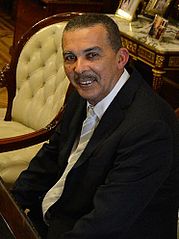Anthony Carmona
| Data i miejsce urodzenia | |
|---|---|
| Prezydent Trynidadu i Tobago | |
| Okres | |
| Przynależność polityczna | niezależny |
| Poprzednik | |
| Następca | |
| Sędzia Międzynarodowego Trybunału Karnego | |
| Okres | |
Anthony Thomas Aquinas Carmona (ur. 7 marca 1953 w Palo Seco) – trynidadzki prawnik i sędzia. Sędzia Międzynarodowego Trybunału Karnego w latach 2012–2013. Prezydent Trynidadu i Tobago od 18 marca 2013 do 19 marca 2018.
Życiorys
Anthony Carmona urodził się w 1953 w Palo Seco na południu Trynidadu jako najstarszy z sześciorga rodzeństwa. Ukończył szkołę podstawową Santa Flora Government Primary School, a następnie Presentation College w San Fernando[1]. W latach 1973-1977 studiował język angielski i nauki polityczne na Uniwersytecie Indii Zachodnich z siedzibą w Monie na Jamajce, a od 1978 do 1981 prawo na oddziale tej uczelni w Cave Hill w Barbadosie. Od 1981 do 1983 studiował prawo w Hugh Wooding Law School w Saint Augustine w Trynidadzie i Tobago[2].
W 1983 został przyjęty w szeregi krajowej adwokatury[3]. Wcześniej, w latach 1972-1978 pracował jako nauczyciel w szkołach średnich na Trynidadzie oraz na Jamajce, a od 1981 do 1984 był wykładowcą na Wydziale Lingwistycznym Uniwersytetu Indii Zachodnich w Saint Augustine[2].
W latach 1983-1989 wykonywał zawód adwokata. W 1989 rozpoczął pracę jako prokurator, którą kontynuował do 2001. W latach 1995-1999 pełnił funkcję zastępcy prokuratora generalnego, a od sierpnia do września 1999 wykonywał jego obowiązki[2][3].
W tym czasie zajmował również urząd doradcy prawnego prezydenta Arthura N.R. Robinsona ds. związanych z Międzynarodowym Trybunałem Karnym (MTK) oraz uczestniczył w pracach Komitetu Przygotowawczego ds. powołania MTK. Reprezentował Trynidad i Tobago na wielu międzynarodowych konferencjach związanych ze sprawami przestępczości, korupcji, ekstradycji, przemytu narkotyków i prania brudnych pieniędzy, ochrony świadków, rozwoju systemu prawa karnego oraz sposobów jego egzekwowania[2][3].
W latach 2001-2004 pracował jako oskarżyciel apelacyjny w Biurze Prokuratora Międzynarodowego Trybunału Karnego dla byłej Jugosławii z siedzibą w Hadze oraz w Biurze Prokuratora Międzynarodowego Trybunału Karnego dla Rwandy z siedzibą w Aruszy, prowadząc procesy odwoławcze osób skazanych przez obydwie instytucje[2][3].
Od 2004 do 2012 zajmował stanowisko sędziego Wydziału Karnego Sądu Najwyższego Trynidadu i Tobago. 12 grudnia 2011 został wybrany sędzią Międzynarodowego Trybunału Karnego na dziewięcioletnią kadencję, którą rozpoczął w Izbie Orzekającej 11 marca 2012[2][3].
3 lutego 2013 został mianowany przez premier Kamlę Persad-Bissessar kandydatem na urząd prezydenta Trynidadu i Tobago[4]. Jego kandydatura zyskała również wsparcie ze strony opozycji. 15 lutego 2013, jako jedyny kandydat, został jednogłośnie wybrany przez Zgromadzenie Elektorów, składające się z obu izb parlamentu, na urząd szefa państwa[5], który objął 18 marca 2013[6].
Przypisy
- ↑ Carmona’s parents pleased as punch (ang.). newsday.co.tt, 5 lutego 2013. [dostęp 2013-03-04].
- ↑ a b c d e f Curriculum Vitae (ang.). icc-cpi.int, 2011. [dostęp 2013-03-04].
- ↑ a b c d e Judge Anthony T. CARMONA (Trinidad and Tobago) (ang.). icc-cpi.int. [dostęp 2013-03-04].
- ↑ IT'S JUSTICE ANTHONY CARMONA (ang.). trinidadexpress.com, 4 lutego 2013. [dostęp 2013-03-04].
- ↑ PM's Statement on the Election of President-elect Anthony Carmona (ang.). trinidadexpress.com, 15 lutego 2013. [dostęp 2013-03-04].
- ↑ 5th President of Trinidad and Tobago inaugurated at the Hasely Crawford Stadium (ang.). news.gov.tt, 18 marca 2013. [dostęp 2013-03-19].
Media użyte na tej stronie
Autor: Sodacan, Licencja: CC BY-SA 3.0
Coat of Arms of the Republic of Trinidad and Tobago
The palm tree at the top of the coat of arms was taken from Tobago’s coat of arms before it was joined in political union with Trinidad. The wreath represents the crown of the monarchy of the United Kingdom, Trinidad and Tobago’s colonizers at the time of independence. The shield has the same colours (black, red, and white) as the nation’s flag and carry the same meaning. The gold ships represent the Santa María, La Niña, and La Pinta: the three ships Christopher Columbus used on his journey to the “New World”. The two birds on the shield are hummingbirds. Trinidad is sometimes referred to as the “Land of the Hummingbird” because more than sixteen different species of hummingbird have been recorded on the island. “Land of the Hummingbird” is also believed to have been the Native Amerindian name for Trinidad. The two larger birds are the Scarlet Ibis (left) and the Cocrico (right), the national birds of Trinidad and Tobago. Below the Scarlet Ibis are three hills, representing the Trinity Hills in southern Trinidad, which, it is believed, convinced Columbus to name the island after the Holy Trinity. The island rising out of the waters beneath the Cocrico represents Tobago. Below these birds is the nation’s motto, "Together We Aspire, Together We Achieve." Adopted in 1962.
(c) Casa Rosada (
El presidente de Trinidad y Tobago, Anthony Carmona.


